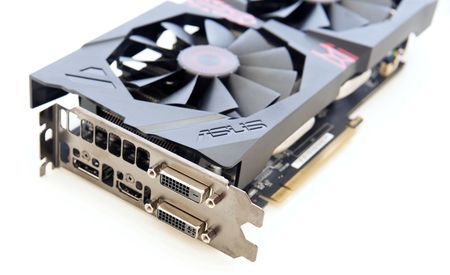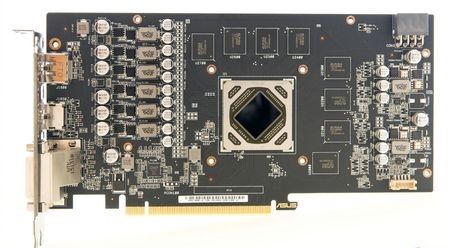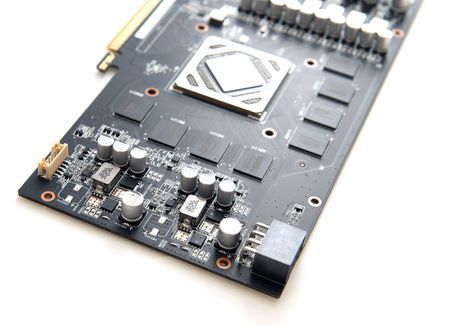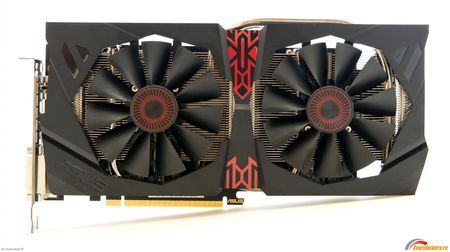Review ASUS Radeon R9 380 Strix OC (Strix-R9380-DC2OC-2GD5-Gaming)
Introduction
Strictly speaking, the graphics accelerator AMD Radeon R9 380 is not unique. After all, we face a well-studied graphics card Radeon R9 285 . Do you remember her backstory? Veteran GPU Tahiti after several modifications received internal index GCN 1.2, and subsequently adding the frequency and became the basis of video core Tonga.
It is not surprising that immediately after the announcement of Radeon R9 380 AMD partners demonstrated a dozen new models.The reason is simple renaming of one series to another. And I almost forgot, Sapphire, MSI and ASUS took only make adjustments to the working frequencies in the flash BIOS.
ASUS has introduced four versions of Radeon R9 380 included in the line of Strix: 2 and 4 GB of memory, two with and two without overclocking. And one of them, who became a hero of the material “video cards AMD Radeon R9 380 2048 MB: catch up and overtake”, you know. This ASUS Radeon R9 380 Strix OC – version with 2 GB of memory and a semi-cooling system. Apart from a detailed study of new items we will address another interesting point.
Announce GPU Tonga held in the autumn of 2014, but many users still do not know how to easily and simply to circumvent the limit AMD’s TDP + 20%. In the course of this article we will touch upon the topic and describe the process of increase of + 100%. After deterrent overclocking graphics cards AMD, have been and remain the notorious 20%. And here it is appropriate to recall that theASUS Radeon R9 285 Strix has already visited the laboratory.
As for the video output, here we are waiting for a standard set of four ports: a pair of DVI, one HDMI and DisplayPort.
It is worth noting that due to the bulging of the angle housing cooling system to obtain a wide card. Theoretically it might interfere with installation in narrow hulls or system ITX.
Printed circuit board
ASUS engineers have developed their own PCB without regard to the reference design. The whole system of the power of the GPU moved forward. At the opposite end by a transmitter memory and PLL.
For comparison photos PCB previously studied ASUS Radeon R9 285 Strix.
At first glance it may be considered, if the board twins, but on closer examination the differences are more than enough. Firstly, the new model is powered by Strix single socket 8pin, and used the previous couple 6pin.
Number of phases fewer now there are six. In the old design was structurally incorporated seven phases: two phases through doublers drivers turned into four, another driver was connected to a single phase power supply, and the last doubler side by side with a single wired phase (area under the seventh empty).
In a new video card drivers installed just three-doubler, connect to them the maximum possible number of phases. And now the power supply system is weakened somewhat compared to the previous version.
But other features are stored. The power connector is still rotated 180 degrees, so they were easy to use. There is a display of power.
Variable memory power components have changed, but it also provides a combination of 1 + 1 phase.
PWM controller to re-mark the name of Digi + ASP1300. This is one of the options of controllers CHil. To date, he is well recognized by most programs for overclocking.
Eight memory chips Elpida manufacturing wired from the front side of the PCB. They are designed for speeds up to 1500 MHz (effective frequency 6000 MHz), bus width is 256 bits.
Unfortunately, the production of Elpida does not like to work at higher than stated by the manufacturer, frequency, but sometimes there are pleasant exceptions to the rule. While most everything is limited ~ 1600 MHz frequencies.
The graphics core Tonga, installed on the ASUS Radeon R9 285 Strix, released in 2014 and marked as 215-0851128.
The new revision brings other identification – 215-0877000. I admit that AMD has made some manipulations with the design inside the chip. But one hundred per cent sure that all concerned exclusively optimizations to reduce the marriage in the production and hardly connected with making improvements on the energy consumption, or frequency potential.
The nominal frequency of the video card ASUS Radeon R9 380 Strix OC was 990 MHz for the GPU and 1375 MHz for the memory.
Cooling system
2015 was the year of the introduction of a semi-fan control systems. And the scheme of all the cards line Strix simple. While the GPU temperature is within the predetermined area, the fans are silent, and if the temperature rises, they start to rotate.
The main problem of such schemes – is to ask the right soft start for turntables and record it in the way of BIOS. Fortunately, ASUS has long been preparing for the implementation, so in this respect I have no complaints.
A pair of 95mm fans got aggressive angle of the blades. At speeds over 1,000 rev / min noise of them abound.
Additionally, the video card installed protective plate on the back side. Its role is purely decorative, besides the back it covers the protruding part of the main radiator. To it has secured a small cooler VRM.
Heat spreader power system put on the screws and contacts through a thermo-power transistors. It is located quite successfully – in the area of blowing fan.
Generally the radiator is used a combination of two types of heat pipes 10 and 8 mm. Again, in the tradition of ASUS, is present and “direct contact” with tubes GPU. It can be seen that the fins do not involve all the available space under the hood – the engineers may well increase it by adding ribs.
There guess that is what ASUS is already using this radiator on the other models of its video cards. This is what we say and additional holes made for compatibility with the landing sizes GPU Tonga.
Alas, the thickness of the radiator is small, because its dimensions are sacrificed thick fans. What is more important, effective and powerful radiator turntables?
But back to the question of the origin of the fan models that can run on ultra-low speeds. This product is labeled FirstD FD9015U12S, turntables real size is 95 mm.
Conclusion
So, ASUS Radeon R9 380 Strix OC is an updated version of the ASUS Radeon R9 285 Strix. The company’s engineers have slightly changed the power system and reduce the number of power connections, replacing a bunch of 6 + 6 pin one 8 pin. At the same time the rest of the chips, including the display connection and a semi-cooling system («DirectCU II with 0dB fan») remains in place.
But after meeting with a video card issues arise. Why now the fans do not rotate at very low (less than 700 r / min) speed, and operates from 900 r / min? Let the time of launch, compared with the previous model has become smoother, but the current reality is not enough competition. And at first glance, we face a decision without significant average bonuses.
Nevertheless, it is necessary to thank the developers for normal program ASUS overclocking – GPU Tweak II, which is available for setting voltage of 1.35 V. Due to this and ways to circumvent the protection of AMD graphics core Tonga gets a second chance to disperse.







